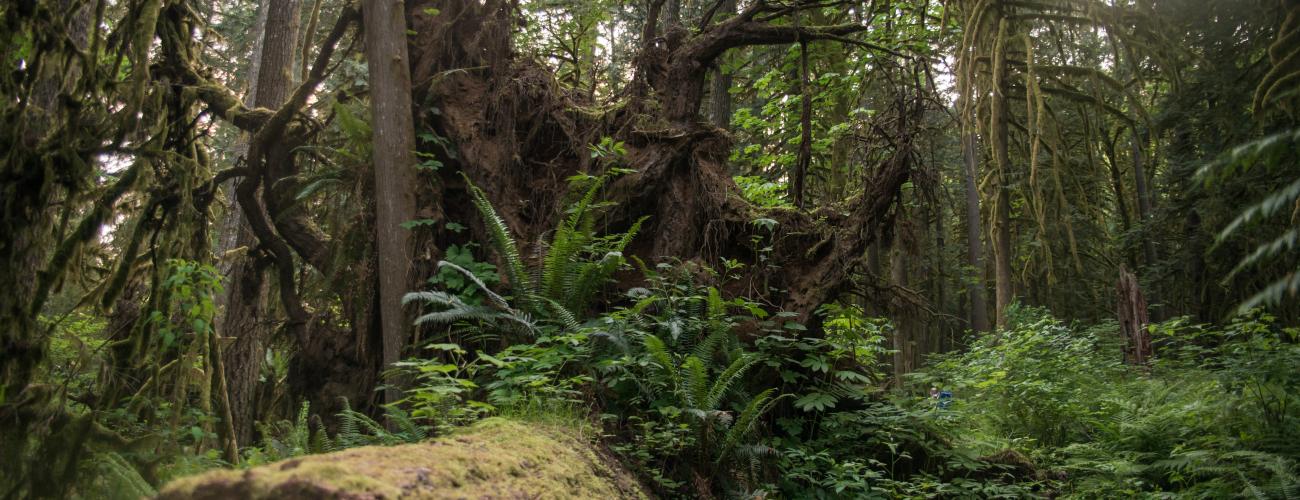Rockport State Park History
Rockport State Park is renowned for its forest of giant Douglas fir, western red cedar and western hemlock trees--some more than 600 years old. The classic old growth forest features large trees, standing snags, decaying logs and layered, multi-aged forest species. It has held great value for people through the ages, although it has been valued in different ways in different times.
Indigenous Land
The park lies within the traditional territory of Coast Salish Indigenous people whose present-day descendants include members of the Upper Skagit Indian Tribe, Sauk-Suiattle Indian Tribe, and Swinomish Indian Tribal Community. These Indigenous cultures make extensive use of western red cedar trees for clothing, basketry, dwellings, artwork and especially the dugout canoes used to travel the Skagit River.
Local tribes ceded ownership of the area to the US federal government in the Treaty of Point Elliot in 1855, keeping rights to harvest natural resources in their usual and accustomed places, including the Skagit River watershed. After government land surveys were completed, the land that makes up today’s Rockport State Park passed into private ownership with a Homestead Entry patent in 1891 and Cash Entry patents, a type of land sale of public domain lands, in 1890 and 1894. Eventually the land was purchased by the Sound Timber Company for potential logging when access became available.
Timberland Trade
In 1899 Friedrich Weyerhaeuser purchased a controlling interest in the Sound Timber Company, acquiring their timberlands in the Darrington-Rockport area, including the land in today’s Rockport State Park. Logging occurred on most of the acquired lands, but the hundreds of acres of giant trees that greet today’s park visitors were spared.
On March 9, 1931, Governor Roland H. Hartley signed Senate Bill 18, authorizing the exchange of state trust lands to acquire lands for park purposes. Commissioner of Public Lands Albert C. Martin presented a proposal for an exchange with Sound Timber Company, trading 556 acres of state trust lands closer to Sound Timber’s operations for the land making up today’s park. The assessment of the land and timber values of the two parcels was discussed at a joint meeting of the State Parks Board and the State Lands Board on October 25, 1933, and the Parks Board members unanimously agreed to proceed. It was approved by the Board of State Land Commissioners on July 23, 1935. The site was officially named Rockport State Park on August 7, 1942. The Washington State Parks and Recreation Commission (WSPRC) allocated $5,000 for improvements, including campsites and trails at the park on May 13, 1958, transferring most of the funds to the Department of Natural Resources (DNR) fire crew to perform the work.
Becoming a State Park
The lease of the exchanged lands to the WSPRC was formalized by Commissioner of Public Lands Bert Cole on March 14, 1961.
In 1971, the Washington Legislature decided that continued lease of trust lands for park purposes was not in the best interest of the state and directed DNR and WSPRC to negotiate a sale of the leased lands. The two agencies entered into a contract for the purchase of 15,083 acres in 24 parks, including 457 acres in Rockport State Park, at a total purchase price of $11.4 million. However, the timber on the lands was excluded from the contracts, as there was no source of funding. The timber in Rockport State Park alone was appraised to be more than 20 million board feet valued at $6.4 million, surpassed only by the value of timber in Lewis and Clark State Park among the leased park areas. In 1980, the legislature authorized the sale of bonds to cover the cost of the timber; on September 28, 1981, about half of the timber in Rockport State Park was deeded to WSPRC. The remainder of the timber was deeded to WSPRC on October 7, 1992, securing its permanent protection.
In 2007, park managers and arborists realized that falling limbs from the aging trees posed a significant hazard to campers. The difficult decision was made to close the park campground and preserve the ancient forest.
Sharing the histories of Washington’s state parks is an ongoing project. Learn more here.

